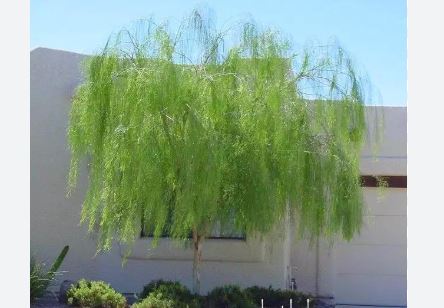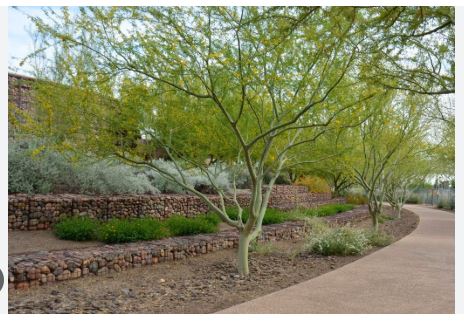
Palo Blanco, Mariosousa willardiana, belongs to the Fabaceae family (legume family) within the subfamily Mimosoideae. The genus Mariosousa, named after Mexican botanist Mario Sousa, includes about 13 species, split from the Acacia genus following the 2005 International Botanical Congress due to DNA evidence distinguishing non-Australian acacias.
Previously known as Acacia willardiana or Mariosousa heterophylla, its current name reflects its taxonomic reassignment. As a legume, it may contribute to soil nitrogen, though this is less studied in Mariosousa compared to other genera. Its classification aligns it with other desert-adapted trees like mesquite.
Mariosousa willardiana is a semi-evergreen, slender tree growing 15–20 feet tall and 10–15 feet wide, with a weeping, willow-like form. Its most striking feature is its exfoliating white bark, peeling in papery scrolls that reveal a smooth, pale trunk, often used by hummingbirds for nesting.
The foliage consists of long, shoestring-like phyllodes (flattened leaf stalks) 10–20 inches long, with small, pinnately compound leaves at the tips that drop in spring and summer. Creamy-white, powder-puff flowers bloom in spring on branched stalks, followed by small brown pods. The tree’s airy, pendulous habit and fine texture distinguish it in desert landscapes.
Palo Blanco is native to the Sonoran Desert, specifically rocky slopes and canyons south of Hermosillo, Sonora, Mexico. Its natural range is limited to this region, where it grows in arid, hot environments with well-drained soils. Due to its ornamental appeal, it is widely cultivated in Arizona, southern California, and other desert regions of the southwestern U.S., as well as in xeriscape gardens globally. It does not naturalize aggressively but is a staple in desert botanical gardens, such as those in Phoenix and Tucson, for its elegant form and adaptability.
Mariosousa willardiana is hardy in USDA Zones 9–11, tolerating temperatures down to about 15–25°F (-9 to -4°C), though young trees may suffer damage at 26°F (-3°C) and mature ones at 20°F (-7°C). It thrives in extreme heat and full sun, making it ideal for desert climates like Arizona and Sonora. In colder areas (Zone 8), it requires protection, such as trunk wraps or frost cloth, during freezes, or can be grown in pots and moved indoors. Its cold sensitivity limits its use in higher elevations or northern deserts.
Palo Blanco is primarily an ornamental tree, prized for its graceful, weeping form, white peeling bark, and drought tolerance, making it a focal point in small desert gardens, courtyards, or patios. It provides light shade, suitable for underplanting with sun-loving species like penstemon or agaves, and is often planted in groups of three for visual impact.
Its flowers attract pollinators, and its bark supports hummingbird nesting. The Seri people historically used its wood for building, and its non-toxic, thornless nature makes it safe near walkways. In xeriscape designs, it reduces water use and enhances aesthetics, though its leaf drop makes it less ideal near pools.

How To Grow And Care For Palo Blanco
Choose a Sunny Location
Select a site with full sun, as Palo Blanco requires at least 6–8 hours of direct sunlight daily for optimal growth and form. Ensure the location accommodates its mature size, typically 15–20 feet tall and 10–15 feet wide, with space for its weeping branches. Avoid shaded or low-lying areas prone to water pooling, as the tree prefers dry, well-drained conditions.
Ensure Well-Drained Soil
Plant in well-drained, sandy, or gravelly soil with a pH of 6.0–8.0, mimicking its native desert habitat. Palo Blanco tolerates poor, rocky soils but is susceptible to root rot in heavy clay or poorly drained areas. Test soil drainage by digging a hole and filling it with water; it should drain within a few hours. Amend with sand or decomposed granite if needed to improve drainage.
Plant in the Optimal Season
Plant in spring or early fall to allow roots to establish before extreme summer heat or winter cold. Dig a hole twice as wide and as deep as the root ball, ensuring the root collar sits at ground level. Backfill with native soil, avoiding heavy amendments, as the tree thrives in lean conditions. Water thoroughly after planting and mulch lightly to retain moisture.
Water Strategically During Establishment
Water deeply but infrequently during the first 1–2 years, providing 1–2 inches of water every 7–10 days in summer, less in cooler months. Use a soaker hose or drip irrigation to target the root zone, avoiding trunk saturation. Once established, Palo Blanco is highly drought-tolerant, requiring supplemental water only during extreme heat or prolonged dry spells (every 2–4 weeks).
Mulch with Inorganic Materials
Apply a 1–2-inch layer of inorganic mulch, such as gravel or decomposed granite, around the base, extending to the drip line but keeping it 3–4 inches from the trunk to prevent rot. Inorganic mulch mimics desert conditions, conserves moisture, and reduces weed competition without retaining excess water, which could harm the tree.
Avoid Fertilization
Palo Blanco thrives in nutrient-poor soils and rarely needs fertilization. Excessive nutrients, especially nitrogen, can cause weak, leggy growth and reduce drought tolerance. If growth is poor in extremely sandy soils, apply a light, low-nitrogen fertilizer (e.g., 5-10-10) once in early spring during the first year, but avoid routine feeding to maintain the tree’s natural resilience.
Prune Minimally for Structure
Prune lightly in late winter or early spring to remove dead, damaged, or crossing branches and to maintain the tree’s graceful, weeping form. Avoid heavy pruning, as Palo Blanco has a naturally open structure and may not resprout vigorously from old wood. Use clean, sharp tools to shape young trees, encouraging an airy canopy, and remove any basal suckers to preserve aesthetics.
Monitor for Pests
Palo Blanco is largely pest-free but may occasionally attract aphids or spider mites in hot, dry conditions. Check for sticky residue, curled leaves, or webbing on phyllodes. Treat minor infestations with a strong water spray or insecticidal soap, ensuring good air circulation to prevent recurrence. Encourage natural predators like ladybugs to maintain pest control.
Prevent Root Rot
The tree is susceptible to root rot (e.g., from Phytophthora or Armillaria) in poorly drained or overwatered soils. Ensure proper drainage and avoid frequent, shallow watering. If leaves yellow, wilt, or drop excessively, inspect the root zone for soggy conditions. Remove affected roots and improve drainage; severe cases may require replanting in a better-drained site.
Protect from Frost Damage
In Zones 9–11, Palo Blanco tolerates light frosts, but young trees are vulnerable to temperatures below 26°F (-3°C), and mature ones below 20°F (-7°C). In Zone 8 or during rare freezes, cover young trees with frost cloth or burlap, and mulch the root zone with gravel to insulate. In colder regions, grow in pots and move indoors during winter, maintaining temperatures above 15°F (-9°C).
Support Pollinators and Wildlife
The tree’s creamy-white spring flowers attract bees and other pollinators, while its peeling bark provides nesting material for hummingbirds. Avoid pesticides during blooming to protect pollinators. Pair with desert natives like brittlebush or fairy duster to create a pollinator-friendly xeriscape, enhancing ecological value in arid gardens.
Propagate with Care
Propagate Palo Blanco via seeds or cuttings, though seeds are more common due to the tree’s slow rooting from cuttings. Collect pods in late summer, scarify seeds to break dormancy, and soak in warm water for 24 hours before planting in a sandy mix. Germination takes 2–4 weeks in warm conditions. Cuttings require semi-hardwood taken in summer with rooting hormone, but success rates are lower.
Select Appropriate Cultivars or Companions
While Mariosousa willardiana has few named cultivars, select nursery stock labeled for upright or weeping forms to match your design goals. For small spaces, choose specimens with compact habits. Pair with low-water plants like agaves, yuccas, or penstemons to complement its fine texture and maintain a cohesive desert aesthetic, ensuring all plants share similar water and sun needs.
Additional Tips
- Staking: Stake young trees in windy desert areas for the first year to stabilize roots, using flexible ties and removing stakes after establishment to promote trunk strength.
- Leaf Drop: Expect seasonal leaf litter from phyllodes and pods, so avoid planting near pools or high-traffic areas to minimize cleanup.
- Long-Term Care: With a lifespan of 20–30 years, regular monitoring for trunk damage or overwatering ensures longevity. Use in groups of three for dramatic effect in xeriscape designs.